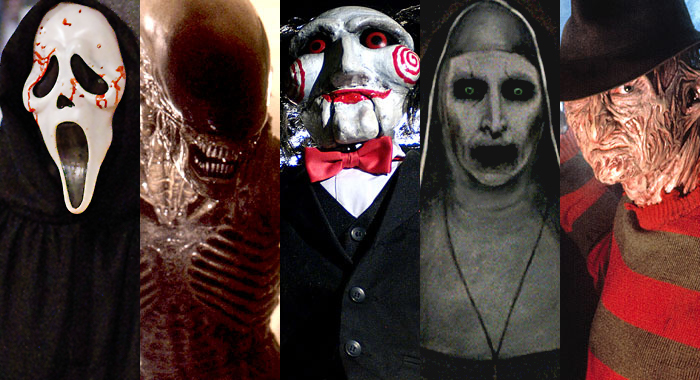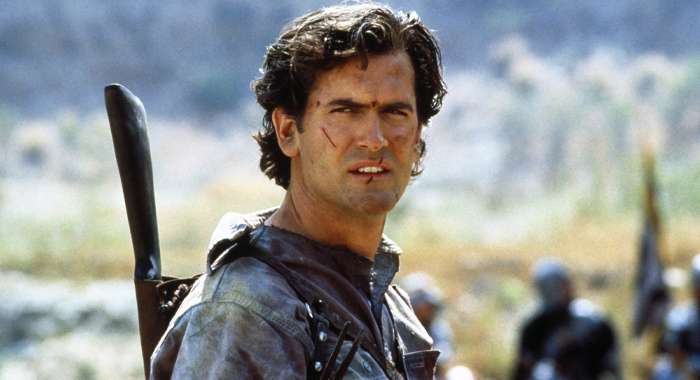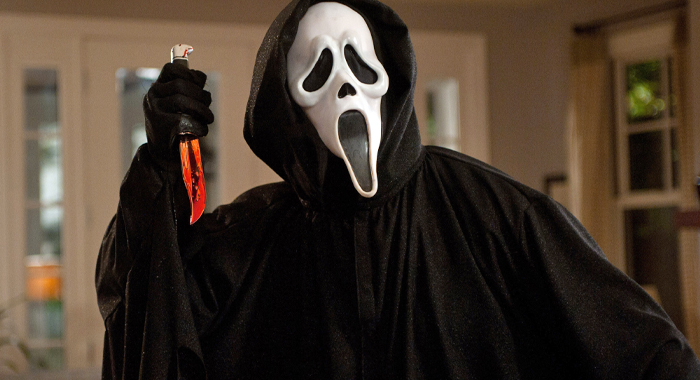TAGGED AS: franchise, Horror, movies

(Photo by Phil Bray/©Dimension Films, ©20th Century Fox Film Corp., ©Lionsgate, ©New Line Cinema, Everett Collection)
In December 1973, a game-changing horror film starring Max von Sydow, Ellen Burstyn, and Linda Blair was released into theaters and immediately became a colossal success, thanks to its horrifying visuals and creative use of pea soup-colored porridge. Directed by William Friedkin (Sorcerer, The French Connection) and written by William Peter Blatty, The Exorcist was a smash hit that pulled in $428 million worldwide and was nominated for 10 Oscars. It’s one of the most successful horror movies ever, and it spawned five Rotten sequels or prequels that have largely failed to measure up to the 1973 classic (admittedly, The Exorcist III has its share of fans). The latest is the David Gordon Green-directed The Exorcist: Believer, which also couldn’t shake its franchise demons and currently sits at 24% on the Tomatometer.
With the release of The Exorcist: Believer, we decided to look back and update a piece we did, examining which long-running horror franchises are the best, statistically speaking. We pulled the data on horror franchises that have at least five theatrically released films and came up with 19 competitors. We counted sequels, remakes, reboots and prequels as part of each franchise, and sadly, we had to leave a few classic ones out because they didn’t have reliable box office or Tomatometer data. We have nothing personal against Count Dracula or Frankenstein’s Monster; we just don’t have enough box office information or reviews to cover all their movies across the decades.
All of the 19 franchises were ranked in each of the six categories below. The winner was the franchise who had the lowest total score (think closest to the No. 1 spot) from the six categories. In other words, the lowest possible score would be 6 (if a film placed first in every category), and the highest would be 96 (if it placed last in every category). Here’s what we looked at:
We felt like it was important to do a “sequels only” category because we wanted to see which of the franchise’s follow-up installments held up on their own merit. For instance, The Texas Chain Saw Massacre is Certified Fresh at 89% on the Tomatometer, but its sequels, remakes, reboots, and reboot-quels sport a dismal 26.5% average. That’s a big gap!
Without further ado, let’s dive into the numbers and see which Horror Franchise is the bloody best.

(Photo by ©20th Century Fox Film Corp. courtesy Everett Collection)
In 1987, the John Mctiernan-directed Predator introduced the world to the now iconic Yautja (aka the Predator), an alien hunter who stalks and murders an overmatched group of muscular heroes led by Arnold Schwarzenegger in its quest to bring home some sweet human bone trophies. The film leaned heavily into the action genre for thrills, but it also embraced horror elements, as the hunter rips out its victims’ spines, skins them, and hangs them upside down for all to see. Created by Stan Winston, the Yautja was far too cool to limit to just one appearance. The problem is, with sequels come diminishing returns, and the Predator movies have been hit or miss since 1987, with only 2010’s Predators and 2022’s Prey achieving Fresh Tomatometer scores.
There is fun to be had in the series, though. Watching Danny Glover battle a one-armed monster aboard its ship in Predator 2 was a world-expanding delight, and seeing Sanaa Lathan become an honorary Yautja in Alien vs. Predator was amazing. Also, Predators features Walton Goggins, Danny Trejo, Mahershala Ali, Alice Braga, and Laurence Fishburne, which is pretty cool, if you ask us.

(Photo by ©FilmDistrict courtesy Everett Collection)
The $1.5 million-budgeted Insidious (2010) might be one of the most important horror films of the last 13 years, because it not only boosted the reputation of Blumhouse Productions, but it also gave director James Wan and writer Leigh Whannell a major hit when they needed one the most. After the Rotten results of Dead Silence and Death Sentence, Wan and Whannell scaled things back, partnered with Jason Blum, and their little $1.5 million dollar movie starring Rose Byrne, Patrick Wilson, and Lin Shaye went on to make a little over $100 million worldwide. Thirteen years later, the five Insidious films have grossed $741 million worldwide on an average budget of $8.5 million. These PG-13 films about groups of nice people who battle not-so-nice demons have carved out a nice niche for themselves in the horror world, and it’s notable that horror legend Lin Shaye was able to carry Insidious: Chapter 3 and Insidious: The Last Key to $293 million worldwide.
The 46.8% Tomatometer average is Rotten, which is a bit disappointing, but the franchise’s box office haul, combined with the fact that Insidious: The Red Door is the highest-grossing fifth entry in a horror franchise ever, softens the blow a bit. Also, knowing that Wan and Whannell have gone on to direct modern horror classics like Malignant, The Invisible Man, Upgrade, and The Conjuring since 2010 makes us appreciate Insidious all the more.

(Photo by New Line Cinema courtesy Everett Collection)
What separates the Nightmare on Elm Street franchise from its iconic counterparts like Halloween and Friday the 13th is that it produced Fresh sequels, namely A Nightmare on Elm Street 3: Dream Warriors and Wes Craven’s New Nightmare. It probably could have lived off the goodwill of Wes Craven’s 1984 original, which introduced the world to Freddy Kreuger (Robert Englund) and “final girl” Nancy Thompson (Heather Langenkamp). However, the series took chances and produced memorable sequels that introduced new storylines, likable characters (Kristen and Kincaid forever), and a meta-narrative that actually made Freddy scary again (New Nightmare) after he’d become a pop-culture caricature spouting one-liners.
Even the Rotten sequels like the Renny Harlin-directed A Nightmare on Elm Street 4: The Dream Master (52%, which is honestly not bad for a horror sequel) featured all-time horror kills like the demise of Debbie (Brooke Theiss), the weight-lifting badass who is transformed into a cockroach. Then, there’s A Nightmare on Elm Street 2: Freddy’s Revenge, a cult classic that recently enjoyed a second life with the release of Scream, Queen! My Nightmare on Elm Street, the Certified Fresh (at 100%, no less) 2019 documentary that focuses on star Mark Patton’s life after the sequel; it’s absolutely worth a watch.

(Photo by Lionsgate courtesy Everett Collection)
Despite only one of its films earning a Fresh Tomatometer score, the Saw franchise guaranteed itself a spot in this list with a solid audience score average of 67.9%, which had it ranked behind only the Hannibal and Evil Dead franchises. One of the neat legacies of this franchise is that it has an average domestic box office of $71.5 million (12th highest average of the 19 franchises) on an average budget of $9 million — it’s extremely profitable. It’s also a critic-proof property that tells a wildly interconnected story that has kept the saws spinning since 2004. It’s noteworthy that the film’s main antagonist, John Kramer (Tobin Bell), was killed in Saw III (sorry if that’s a spoiler, but it’s been 17 years), and the following films manage to continue his legacy while introducing new villains who all make sense, more or less, in the overarching plot. Check out the timeline; it’s a wild web of murderers, victims, and surprise villains who all belong in the world because of John Kramer’s knack for planning. It’s like he saw it all coming…
Note: Saw X’s box office wasn’t included in our calculations because it’s still in theaters, and we don’t know exactly where its total haul will end up.

(Photo by Everett Collection)
With Night of the Living Dead, Dawn of the Dead, Day of The Dead, Land of the Dead, and Diary of the Dead all being Fresh, it’s no shock that George Romero’s zombie franchise cracked the top 10. Romero’s films, which started with 1968’s seminal Night of the Living Dead, are all-time horror classics that combine the thrill of undead flesh-eaters with commentaries on race relations, consumerism, and gentrification. Though other zombie movies predate Night of the Living Dead, this franchise kicked the craze into high gear, and you can see its imprint all over popular culture, from The Walking Dead to Shaun of the Dead and countless others in between.
One thing that makes this franchise unique is that two of its remakes are Fresh. The 1990 remake of Night of the Living Dead, directed by Tom Savini, is a Fresh delight that features a better Barbara (she is coming for the zombies this time) and showcases what happens when people realize the zombies are ridiculously slow. The 2004 remake of Dawn of the Dead is notable as it was Zack Snyder’s first film, and Certified Fresh at 76%, it’s still his best-reviewed movie. Both belong in the Horror Remake Hall of Fame, as they are companion pieces to their source material that branch out in their own directions and offer new twists.

(Photo by Michael Tackett/©Warner Bros. Pictures)
Not content with kickstarting the Saw and Insidious franchises, James Wan began work on The Conjuring in early 2011. The film would center around Ed and Lorraine Warren, a real-life married couple whose paranormal investigations during the 1950s and beyond became world renowned. Wan secretly might have wanted another crack at evil doll supremacy too, as his underappreciated 2007 film Dead Silence failed to hit at the box office, and he used The Conjuring to introduce Annabelle for a future spin-off.
In 2013, The Conjuring exploded onto the scene with a $41.8 million opening weekend and an impressive Certified Fresh 86% Tomatometer score. Starring Vera Farmiga and Patrick Wilson as the Warrens, the R-rated feature was a blockbuster smash that cleared $300 million worldwide and opened up the door for a new universe of horror films featuring evil nuns, evil dolls, and an evil entity named Valak (lots of evil).
The nine Conjuring Universe films released since 2013 have grossed $2.2 billion, and only The Curse of La Llorona, which made $121 million worldwide (on a $9 million budget, so it was still profitable) failed to cross the $200 million milestone. It has become a legitimate juggernaut whose reputation is so strong that The Nun, Rotten at 24% with an Audience Score of 35%, was still able to make $363 million off of its association with the series.
What’s arguably most impressive about the Conjuring Universe is the Annabelle spin-offs. Annabelle: Creation and Annabelle Comes Home are both Fresh films that far surpassed 2014’s Annabelle in quality and scares. The producers could have phoned it in after seeing the $256 million worldwide haul (on a $6.5 million budget) of the first Annabelle, but instead they brought in directors David F. Sanberg (Lights Out) and Gary Dauberman (writer of It and It: Chapter Two), and they took chances (like the finger-snapping scene in Creation) that were critically appreciated (68% Tomatometer average) and lucrative ($534 million combined worldwide haul).
Note: We included the Tomatometer and Audience Scores for The Nun II, but excluded its box office because it is currently still in theaters.

(Photo by 20th Century Fox Film Corp. courtesy Everett Collection)
In space, no one can hear you scream, but you’d better believe the people waiting in line for popcorn heard the screams coming from the theaters playing Ridley Scott’s Alien in 1979.
Between Scott’s direction, H.R. Giger’s monster creations, and Ellen Ripley, the all-time hero perfectly portrayed by Sigourney Weaver, Alien became one of the most influential horror films ever made. Imagine sitting in a packed theater and witnessing the reactions to John Hurt’s chest-bursting scene, or Ripley’s final battle with the acid blood-spewing xenomorph (who is also impossibly goey). Now, imagine sitting in a theater in 1986, when Ripley squared-off against the Alien Queen in James Cameron’s sequel Aliens, which earned Weaver a Best Actress Oscar nomination.
Aside from Night of the Living Dead and Dawn of the Dead, Alien and Aliens might be the most impressive back-to-back films in any horror franchise. They helped boost the horror genre to new heights (and not just because they took place in space), and pulled in loads of money during their theatrical runs. If it weren’t for what was to come, the franchise might have landed in the No. 1 spot.
Unfortunately, the series did experience some lows in the 1990s and 2000s, as Alien 3, Alien: Resurrection, and the Alien vs. Predator films all earned Rotten Tomatometer scores. However, Scott turned things around in the 2010s with Prometheus and Alien: Covenant, the Fresh prequels that explore the origins of the xenomorph and demonstrate what happens if you flee from large, tumbling objects in a straight line.

(Photo by ©Universal Pictures)
Sam Raimi’s The Evil Dead (86%), Evil Dead 2 (88%), and Army of Darkness (68%); Fede Alvarez’s Evil Dead remake (63%); and 2023’s Evil Dead Rise (84%) collectively have the highest Tomatometer average of all the horror franchises, and that’s partially due to the fact that it’s the only one without a single Rotten installment (Hail to the king, baby!). What kept it from claiming the No. 1 spot was its low box office earnings, which come nowhere close to the Scream, Hannibal Lecter, and Conjuring franchises. Those low numbers aren’t all that surprising, however, considering the ultra-violence of Evil Dead (2013) and Evil Dead Rise (2023), as well as the polarizing idiocy of Bruce Campbell’s Ash Williams, who blunders his way through Army of Darkness with the confidence of someone who has a great chin and marginal cleverness.
That said, it’s not only the critics who love this franchise; Rotten Tomatoes users think it’s pretty groovy too. The Audience Score average of 80% makes this the highest-rated horror franchise and the only one to achieve an Audience Score of 80% or above, and once again, none of its Audience Scores fall into Rotten territory. The closest any of these films come to Rotten is the 2013 remake, which has a 63% Tomatometer Score and 64% Audience Score. However, when you consider it’s a horror remake, and horror remakes average 39% on the Tomatometer, that 63% looks pretty great.

(Photo by ©Dimension Films)
Let’s get something out of the way: Parker Posey is amazing in Scream 3, and anybody that says otherwise is… absolutely welcome to their opinion because we’re all different and have the right to be totally wrong about the greatness of Parker Posey.
Now, if it weren’t for the Rotten 41% Tomatometer score of Scream 3, the franchise would join the rarified air of the all-Fresh Evil Dead franchise. Five of the six Scream films have Fresh Tomatometer scores, and the 69.3% Tomatometer average is second only to the 77.8% average of the Evil Dead films. Wes Craven’s half satire, half genuine horror series is so beloved that, despite its Rotten score, Scream 3 still made $160 million worldwide, and in 2021, 5cream (or Scream) raked in $139 million worldwide during a pandemic. We know that Scream 4 (2010) wasn’t too popular in 2010, but time has been kind to Craven’s assault on internet fame, and the sequel is now respected for the committed performances from Emma Roberts and Hayden Panettiere (Kirby forever!).
Since 1996, the Scream franchise has been one of the most consistent and successful horror franchises ever, and it has done so by introducing a fresh batch of killers in each installment. Sure, the plan in Scream 6 is baloney, but at a Certified Fresh 76% on the Tomatometer, it’s better than pretty much every other sixth entry in every major horror franchise (Jason Lives is a close second, at least in our hearts). It’s just too bad that none of the Scream films could clear a 90% Tomatometer score or hit the box office heights of The Exorcist, The Silence of the Lambs, or The Nun, because if one of them did, this could have had a chance at the No. 1 spot.

(Photo by Orion courtesy Everett Collection)
In 1986, Manhunter, an adaptation of the Thomas Harris novel Red Dragon, introduced theatergoers to Brian Cox’s Hannibal Lecktor, a serial killer with a taste for human flesh. The Michael Mann-helmed film was a modest success that was praised for its style and performances, but it wasn’t until five years later, with the release of Jonathan Demme’s The Silence of the Lambs, that Hannibal Lecter (Anthony Hopkins) — now spelled correctly — became a household name.
The $130 million domestic haul ($284 million when adjusted for inflation) of The Silence of the Lambs made it the fourth highest-grossing film of 1991, and the five Oscars it won for Best Picture, Best Actor, Best Actress, Best Director, and Best Adapted Screenplay made it not just the only horror film to win Best Picture, but also only the third film ever to sweep all five of the top Academy Award categories (It Happened One Night and One Flew Over the Cuckoo’s Nest are the other two).
While Manhunter, The Silence of the Lambs, and Red Dragon (Fresh at 68%) secured the franchise a spot on this list with their excellent Tomatometer and Audience Scores, Ridley Scott’s 2001 sequel Hannibal ensured the No. 1 finish here with its $165 million domestic haul; apparently, its 40% Tomatometer score didn’t discourage anyone who really wanted to see Anthony Hopkins eat Ray Liotta’s brains. Yes, Hannibal Rising (Rotten at 16%) kept the competition closer than Hannibal would’ve liked, but its comparatively high 55% Audience Score helped create some distance from the other franchises.
In the end, Hannibal Lecter (and Lecktor) won the day with his murderous charms (and excellent numbers), and that’s why his franchise is No. 1 on our list.
Disagree with our findings? Tell us about your favorite horror franchises in the comments!